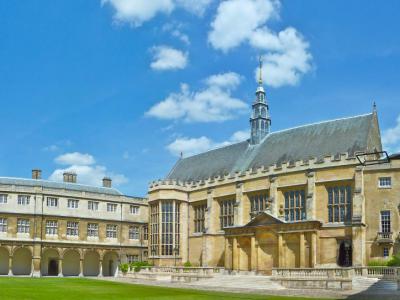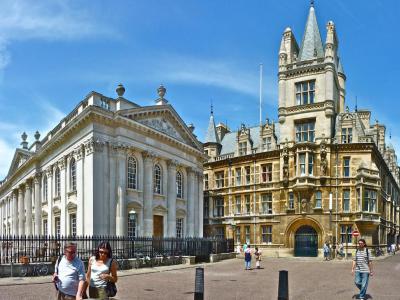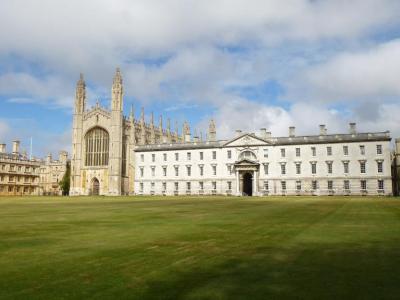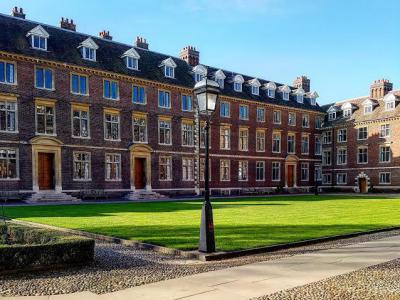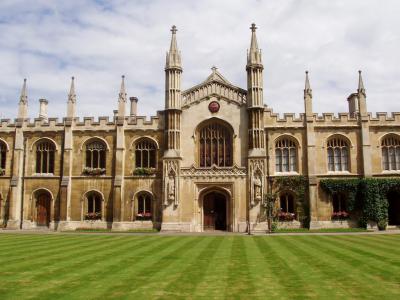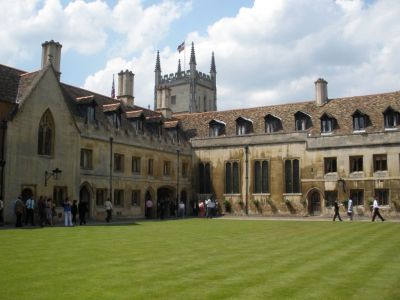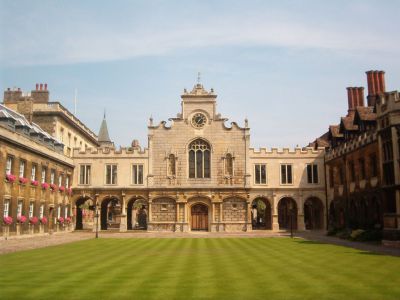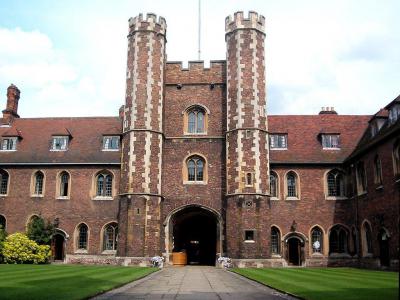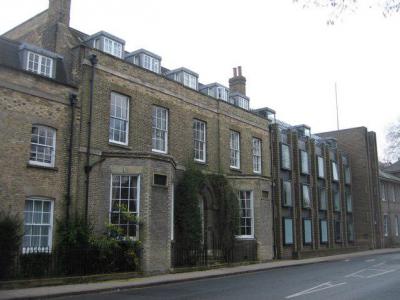Colleges of Cambridge University (Self Guided), Cambridge
The University of Cambridge, England's second oldest learning institution, has made Cambridge famous worldwide. The collegiate university is made up of 31 self-governing and independent colleges whose grounds, apart from having been blessed with world-renowned alumni, are also beautifully decorated with lush lawns and terrific Gothic architecture.
Each of these colleges has its unique character and traditions, making Cambridge a truly diverse and intellectually vibrant place. On this tour, we'll explore some of them.
Trinity College, one of the largest and wealthiest in Cambridge, was founded in 1546. Its Great Court is a famous architectural marvel, and its notable alumni include Sir Isaac Newton and King Charles III.
Gonville and Caius College, often referred to simply as "Caius," was established in 1348 and is known for its science and medical programs, as well as a grand library.
King's College, founded in 1441, is renowned for its beautiful chapel, which hosts the famous Festival of Nine Lessons and Carols every Christmas Eve.
Saint Catharine's College, nicknamed “Catz”, has been in place since 1473. It has among its alumni the likes of actor Sir Ian McKellen (the one who played Gandalf, the wizard, in The Lord of the Rings).
Corpus Christi College, sometimes shortened to "Corpus", was founded in 1352 and it ranks among the wealthiest Cambridge colleges in terms of fixed assets (particularly silver).
Pembroke College, founded in 1347, is one of the university's larger colleges, with buildings from almost every century since its founding, as well as extensive gardens.
Peterhouse is the oldest college in Cambridge, founded in 1284. It is known for its academic excellence and historic dining hall.
Queens' College, founded in 1448, has a stunning riverside location along the Cam River and a beautiful Mathematical Bridge.
Finally, Darwin College, established in 1964, is a relatively newer college and is known for its postgraduate and research programs.
Given the opportunity, we encourage you to explore these distinguished institutions, each with its charm and contributions to the world of academia. Discover the intellectual treasures and the beauty of Cambridge's colleges and experience the legacy of knowledge they represent.
Each of these colleges has its unique character and traditions, making Cambridge a truly diverse and intellectually vibrant place. On this tour, we'll explore some of them.
Trinity College, one of the largest and wealthiest in Cambridge, was founded in 1546. Its Great Court is a famous architectural marvel, and its notable alumni include Sir Isaac Newton and King Charles III.
Gonville and Caius College, often referred to simply as "Caius," was established in 1348 and is known for its science and medical programs, as well as a grand library.
King's College, founded in 1441, is renowned for its beautiful chapel, which hosts the famous Festival of Nine Lessons and Carols every Christmas Eve.
Saint Catharine's College, nicknamed “Catz”, has been in place since 1473. It has among its alumni the likes of actor Sir Ian McKellen (the one who played Gandalf, the wizard, in The Lord of the Rings).
Corpus Christi College, sometimes shortened to "Corpus", was founded in 1352 and it ranks among the wealthiest Cambridge colleges in terms of fixed assets (particularly silver).
Pembroke College, founded in 1347, is one of the university's larger colleges, with buildings from almost every century since its founding, as well as extensive gardens.
Peterhouse is the oldest college in Cambridge, founded in 1284. It is known for its academic excellence and historic dining hall.
Queens' College, founded in 1448, has a stunning riverside location along the Cam River and a beautiful Mathematical Bridge.
Finally, Darwin College, established in 1964, is a relatively newer college and is known for its postgraduate and research programs.
Given the opportunity, we encourage you to explore these distinguished institutions, each with its charm and contributions to the world of academia. Discover the intellectual treasures and the beauty of Cambridge's colleges and experience the legacy of knowledge they represent.
How it works: Download the app "GPSmyCity: Walks in 1K+ Cities" from Apple App Store or Google Play Store to your mobile phone or tablet. The app turns your mobile device into a personal tour guide and its built-in GPS navigation functions guide you from one tour stop to next. The app works offline, so no data plan is needed when traveling abroad.
Colleges of Cambridge University Map
Guide Name: Colleges of Cambridge University
Guide Location: England » Cambridge (See other walking tours in Cambridge)
Guide Type: Self-guided Walking Tour (Sightseeing)
# of Attractions: 9
Tour Duration: 1 Hour(s)
Travel Distance: 1.1 Km or 0.7 Miles
Author: sylvia
Sight(s) Featured in This Guide:
Guide Location: England » Cambridge (See other walking tours in Cambridge)
Guide Type: Self-guided Walking Tour (Sightseeing)
# of Attractions: 9
Tour Duration: 1 Hour(s)
Travel Distance: 1.1 Km or 0.7 Miles
Author: sylvia
Sight(s) Featured in This Guide:
- Trinity College
- Gonville and Caius College
- King's College
- St Catharine's College
- Corpus Christi College
- Pembroke College
- Peterhouse
- Queens' College
- Darwin College
1) Trinity College (must see)
Trinity College, a prestigious constituent of the University of Cambridge in England, is notable not only for its academic excellence but also for its rich history and significant contributions to various fields. Established in 1564 by King Henry VIII through the amalgamation of Michaelhouse and King's Hall, Trinity stands out as the largest and wealthiest college in both Cambridge and Oxford, and it even owns the O2 Arena.
Trinity College has a notable roster of alumni including two members of the British royal family, six British prime ministers, and numerous other distinguished individuals. Among these are 32 Nobel laureates, representing a significant portion of the 90 Nobel prizes awarded to Cambridge affiliates. Some of its most famous alumni include Sir Isaac Newton, King Charles III, and philosopher Ludwig Wittgenstein.
Architecturally, Trinity is renowned for its Wren Library, the largest in Cambridge, housing around 300,000 books and open to the public. The library, along with other historic buildings such as the King's Hostel, the Great Gate, and Neville's Court, illustrates the college's commitment to preserving its heritage while providing modern educational facilities.
The Great Gate, an iconic entrance facing Trinity Street, is usually the first glimpse visitors get of the college. Above its doorway, a statue of Henry VIII, holding a wooden chair leg instead of a scepter due to a historical student prank, greets visitors. This gate leads to the Great Court, reputed to be the largest enclosed quad in Europe, and the central courtyard features a prominent fountain.
Adjacent to the Great Court is Neville’s Court, named after Thomas Neville who was master of the college when he commissioned its construction. It is characterized by its cloisters that provide sheltered walkways linking the Great Hall, the college libraries, and other facilities. The construction of the Wren Library at the end of the 17th century enclosed the court, adding to the grandeur of the college.
Trinity College thus remains a symbol of historical significance, academic achievement, and architectural beauty, continuing to inspire and nurture some of the brightest minds in the world.
Trinity College has a notable roster of alumni including two members of the British royal family, six British prime ministers, and numerous other distinguished individuals. Among these are 32 Nobel laureates, representing a significant portion of the 90 Nobel prizes awarded to Cambridge affiliates. Some of its most famous alumni include Sir Isaac Newton, King Charles III, and philosopher Ludwig Wittgenstein.
Architecturally, Trinity is renowned for its Wren Library, the largest in Cambridge, housing around 300,000 books and open to the public. The library, along with other historic buildings such as the King's Hostel, the Great Gate, and Neville's Court, illustrates the college's commitment to preserving its heritage while providing modern educational facilities.
The Great Gate, an iconic entrance facing Trinity Street, is usually the first glimpse visitors get of the college. Above its doorway, a statue of Henry VIII, holding a wooden chair leg instead of a scepter due to a historical student prank, greets visitors. This gate leads to the Great Court, reputed to be the largest enclosed quad in Europe, and the central courtyard features a prominent fountain.
Adjacent to the Great Court is Neville’s Court, named after Thomas Neville who was master of the college when he commissioned its construction. It is characterized by its cloisters that provide sheltered walkways linking the Great Hall, the college libraries, and other facilities. The construction of the Wren Library at the end of the 17th century enclosed the court, adding to the grandeur of the college.
Trinity College thus remains a symbol of historical significance, academic achievement, and architectural beauty, continuing to inspire and nurture some of the brightest minds in the world.
2) Gonville and Caius College
Gonville and Caius College is one of the oldest and most influential colleges within Cambridge University. Both Oxford and Cambridge Universities, Britain’s two most prestigious places of learning, are made up of affiliate colleges, such as Gonville and Caius. First established in 1348, the college is the fourth-oldest at the University of Cambridge and one of the wealthiest. It owes much of its success and development to the two men who give the college its name – despite the fact they lived two centuries apart. William Gonville founded the college but died three years later. Gonville Hall, as it was then known, moved to its present site shortly afterwards.
John Caius took over the running of the dilapidated college building in 1559, renaming it Gonville and Caius College. He restored and extended the buildings and created the elegant courtyards that still stand today, including Caius Court. Master of the college for 15 years, Caius was renowned for his unusual entry rules, barring the sick and infirm, as well as the Welsh, from studying here. While this rule has thankfully been abandoned, Gonville & Caius is still known for its strong traditions. Meals are eaten communally in the dining hall, often whilst wearing formal gowns. Specialising in sciences, particularly medicine, the college has several famous alumni, including Sir Stephen Hawking and broadcaster Sir David Frost. The college has been attended by many students who have gone on to significant accomplishment, including fourteen Nobel Prize winners, the second-most of any Oxbridge college (after Trinity College, Cambridge).
Why You Should Visit:
To enter and roam around the intimate, peaceful grounds and chapel – and you can do that for no charge.
Tip:
For around £50 you can sleep in an admittedly basic and ancient traditional room in one of the old courts of the main college. You may be woken earlier than you intended by the bells of the adjacent Great St Mary's Church. Included is a full English breakfast in the old hall, lined with paintings of former masters and of Stephen Hawking, the theoretical physicist.
John Caius took over the running of the dilapidated college building in 1559, renaming it Gonville and Caius College. He restored and extended the buildings and created the elegant courtyards that still stand today, including Caius Court. Master of the college for 15 years, Caius was renowned for his unusual entry rules, barring the sick and infirm, as well as the Welsh, from studying here. While this rule has thankfully been abandoned, Gonville & Caius is still known for its strong traditions. Meals are eaten communally in the dining hall, often whilst wearing formal gowns. Specialising in sciences, particularly medicine, the college has several famous alumni, including Sir Stephen Hawking and broadcaster Sir David Frost. The college has been attended by many students who have gone on to significant accomplishment, including fourteen Nobel Prize winners, the second-most of any Oxbridge college (after Trinity College, Cambridge).
Why You Should Visit:
To enter and roam around the intimate, peaceful grounds and chapel – and you can do that for no charge.
Tip:
For around £50 you can sleep in an admittedly basic and ancient traditional room in one of the old courts of the main college. You may be woken earlier than you intended by the bells of the adjacent Great St Mary's Church. Included is a full English breakfast in the old hall, lined with paintings of former masters and of Stephen Hawking, the theoretical physicist.
3) King's College (must see)
King’s College is located on the western side of Cambridge University campus, close to the River Cam and the surrounding Backs area of countryside. The college gatehouse stands adjacent to King’s College Chapel, one of the city’s most iconic buildings. The history of King’s College is one of many paradoxes. Completed in the Tudor era, the college was at one time only accessible to students of Eton, a renowned private school for children of the English upper classes. Nowadays, it has one of the highest intake rates of students from state schools of any Cambridge college.
True to its name, the college was founded by Henry VI and saw heavy investment under his reign, including the creation of the adjoining chapel. Other colleges viewed King’s College as a status symbol for the Tudor monarchy – to this day, many of the buildings, including the striking Gothic gatehouse, feature the Tudor rose emblem repeatedly. Despite its royalist beginnings, King’s College has become known for left wing and republican sentiment among its student base. Famous alumni of the college include authors Salman Rushdie and E.M. Forster.
True to its name, the college was founded by Henry VI and saw heavy investment under his reign, including the creation of the adjoining chapel. Other colleges viewed King’s College as a status symbol for the Tudor monarchy – to this day, many of the buildings, including the striking Gothic gatehouse, feature the Tudor rose emblem repeatedly. Despite its royalist beginnings, King’s College has become known for left wing and republican sentiment among its student base. Famous alumni of the college include authors Salman Rushdie and E.M. Forster.
4) St Catharine's College
Saint Catharine’s College, known locally as Cat’s, is situated on Silver Street, between King’s and Queens’ colleges, close to the River Cam. Founded in 1473, Saint Catharine’s was known as Katherine Hall until the 19th century. It is named after Saint Catharine, the patron saint of learning. Traditionally a moderately successful college, specialising in theology and philosophy, Cat’s has grown in recent years to become one of the best performing colleges within Cambridge University.
The college is notable for its distinctive three-sided ‘quad’ (an area of grass surrounded by faculty buildings). With the fourth side opening onto Trumpington Street, passers-by are offered a unique view into the centre of a Cambridge college. The existing buildings were built across a century, from 1675 to 1757. There have long been plans to create a fourth building hiding the courtyard from view, so the quad may not be visible for much longer.
The college was one of the first in Cambridge to have a female master – Dame Jean Thomas, who was elected in 2007 and remained college master until 2016. Traditionally a sociable, relaxed place of learning, Saint Catharine’s has a number of famous alumni, including TV presenter Jeremy Paxman and actor Sir Ian McKellen. Outside of term time, the historic college is available for hire as a conference centre.
Tip:
You can book one of the guesthouse rooms here to experience how staying in an old heritage college feels like, with breakfast and dinner in the dining hall, college student style, and clean and comfortable rooms (nothing too fancy but very convenient and quite good).
The college is notable for its distinctive three-sided ‘quad’ (an area of grass surrounded by faculty buildings). With the fourth side opening onto Trumpington Street, passers-by are offered a unique view into the centre of a Cambridge college. The existing buildings were built across a century, from 1675 to 1757. There have long been plans to create a fourth building hiding the courtyard from view, so the quad may not be visible for much longer.
The college was one of the first in Cambridge to have a female master – Dame Jean Thomas, who was elected in 2007 and remained college master until 2016. Traditionally a sociable, relaxed place of learning, Saint Catharine’s has a number of famous alumni, including TV presenter Jeremy Paxman and actor Sir Ian McKellen. Outside of term time, the historic college is available for hire as a conference centre.
Tip:
You can book one of the guesthouse rooms here to experience how staying in an old heritage college feels like, with breakfast and dinner in the dining hall, college student style, and clean and comfortable rooms (nothing too fancy but very convenient and quite good).
5) Corpus Christi College
One of the oldest institutions within Cambridge University, Corpus Christi College is located in the heart of the academic district on Trumpington Street, opposite Saint Catharine’s College. It was founded in 1532 and, as its name suggests, has been one of Cambridge’s most religiously active colleges throughout history. For many years, all graduates from this small, wealthy college became members of the clergy. Often at the centre of religious argument and debate in the city, the college was known as Saint Bene’t’s for several years following the Reformation, when Catholicism was outlawed. This relates to nearby Saint Bene’t’s Church, Cambridge’s oldest building, which was once used as the college chapel.
The main Corpus Christi campus is divided into three courts. Old Court is the original college building dating back from its creation, and one of the city’s oldest academic buildings. New Court, completed in 1827, was designed by William Wilkins. The architect considered the courtyard his finest work and is buried within the college chapel, which was built at the same time. The third courtyard is Library Court, a brand new area housing student amenities, which opened in 2008. Together, the three courtyards span the college’s 650-year history.
Why You Should Visit:
The college contains lodges that are the oldest in either Cambridge or Oxford; the lawns are manicured, the buildings are austere and ooze character.
The Parker Library, which has some really spectacular manuscripts, is open to the public, just once a week, and should be visited by everyone, if possible.
The chapel is small, certainly not the size of Kings College, but is unusually bright and lovely for a Cambridge chapel.
As one of the colleges you can enter, this should definitely be on your list.
The main Corpus Christi campus is divided into three courts. Old Court is the original college building dating back from its creation, and one of the city’s oldest academic buildings. New Court, completed in 1827, was designed by William Wilkins. The architect considered the courtyard his finest work and is buried within the college chapel, which was built at the same time. The third courtyard is Library Court, a brand new area housing student amenities, which opened in 2008. Together, the three courtyards span the college’s 650-year history.
Why You Should Visit:
The college contains lodges that are the oldest in either Cambridge or Oxford; the lawns are manicured, the buildings are austere and ooze character.
The Parker Library, which has some really spectacular manuscripts, is open to the public, just once a week, and should be visited by everyone, if possible.
The chapel is small, certainly not the size of Kings College, but is unusually bright and lovely for a Cambridge chapel.
As one of the colleges you can enter, this should definitely be on your list.
6) Pembroke College
Located on the corner of Pembroke Street and Trumpington Street in Cambridge City Centre, Pembroke College is one of Cambridge University’s largest colleges, and also the third oldest, having been founded in 1347. The college was founded by Marie de Saint Pol, the widow of the Earl of Pembroke. Originally known as Valence Mary, it was a specialised place of learning for French graduates living in England, but grew to become one of Cambridge’s most successful institutions. The college chapel was the first building to be designed by Sir Christopher Wren, the architect of Saint Paul’s Cathedral in London.
The college was extensively rebuilt around the old courtyard in the Victorian era. Renowned Victorian architect Alfred Waterhouse redesigned the dining hall and a range of rooms, although these were expanded and modified in the 20th century. Sir Gilbert Scott also designed New Court, an area of student accommodation. Pembroke College therefore contains works from three of Britain’s most celebrated architects. The gatehouse, facing onto Trumpington Street, is the last surviving part of the original medieval college.
Pembroke's enclosed grounds also house some gardens, sporting vegetation. Highlights include "The Orchard" (a patch of semi-wild ground in the centre of the college), an impressive row of Plane Trees and a bowling green, re-turfed in 1996, which is reputed to be among the oldest in continual use in Europe.
Why You Should Visit:
To walk around in the tranquil and immaculately kept gardens; a haven of old and new buildings with statues to the famous and memorials to the fallen – and all for no charge, which is rather rare for central colleges.
Tip:
Don't miss the many charming little features, including a passageway alongside the hall, an old spiral stone staircase, and the Wren chapel.
You do not have to pay to get in and you can actually walk on the grass without being chased by a porter.
The college was extensively rebuilt around the old courtyard in the Victorian era. Renowned Victorian architect Alfred Waterhouse redesigned the dining hall and a range of rooms, although these were expanded and modified in the 20th century. Sir Gilbert Scott also designed New Court, an area of student accommodation. Pembroke College therefore contains works from three of Britain’s most celebrated architects. The gatehouse, facing onto Trumpington Street, is the last surviving part of the original medieval college.
Pembroke's enclosed grounds also house some gardens, sporting vegetation. Highlights include "The Orchard" (a patch of semi-wild ground in the centre of the college), an impressive row of Plane Trees and a bowling green, re-turfed in 1996, which is reputed to be among the oldest in continual use in Europe.
Why You Should Visit:
To walk around in the tranquil and immaculately kept gardens; a haven of old and new buildings with statues to the famous and memorials to the fallen – and all for no charge, which is rather rare for central colleges.
Tip:
Don't miss the many charming little features, including a passageway alongside the hall, an old spiral stone staircase, and the Wren chapel.
You do not have to pay to get in and you can actually walk on the grass without being chased by a porter.
7) Peterhouse
Based on Trumpington Street and founded in 1280, Peterhouse College is Cambridge’s oldest educational institution. The university site sprawls across the area behind the famous Fitzwilliam Museum and has been redeveloped and extended repeatedly throughout its history. The dining hall, off Old Court beyond the chapel cloisters, is the only surviving 13th-century building. It was restored in the 19th century by renowned architect Sir Gilbert Scott.
The chapel itself is the most visible building from Trumpington Street and features a dazzling interior that blends Gothic architecture with Renaissance decoration. The chapel contains manuscripts from its early years, which form an impressive collection of Tudor and Jacobean church music. The area adjacent to the chapel, visible from the main road outside, is known as First Court. This courtyard houses the Perne Library, which has housed Peterhouse’s collection of books and scripts since it was built in 1590.
As Cambridge’s most historic college, Peterhouse has an array of famous alumni. Novelist Kingsley Amis, scientist Lord Kelvin and Sir Frank Whittle, inventor of the jet engine, all studied here. In addition, Peterhouse College is known as a politically conservative college which has educated many Tory party MPs, including Michael Portillo and Michael Howard.
Why You Should Visit:
To explore the parts open to the public, including the small but elegant chapel dating from 1628, the sublime dining hall in dark wood, and the gorgeous and extensive back garden. No tourists, but much beauty.
The chapel itself is the most visible building from Trumpington Street and features a dazzling interior that blends Gothic architecture with Renaissance decoration. The chapel contains manuscripts from its early years, which form an impressive collection of Tudor and Jacobean church music. The area adjacent to the chapel, visible from the main road outside, is known as First Court. This courtyard houses the Perne Library, which has housed Peterhouse’s collection of books and scripts since it was built in 1590.
As Cambridge’s most historic college, Peterhouse has an array of famous alumni. Novelist Kingsley Amis, scientist Lord Kelvin and Sir Frank Whittle, inventor of the jet engine, all studied here. In addition, Peterhouse College is known as a politically conservative college which has educated many Tory party MPs, including Michael Portillo and Michael Howard.
Why You Should Visit:
To explore the parts open to the public, including the small but elegant chapel dating from 1628, the sublime dining hall in dark wood, and the gorgeous and extensive back garden. No tourists, but much beauty.
8) Queens' College
Queens’ College is the southernmost in the chain of prestigious colleges which line the east bank of the river Cam. It is one of only two colleges in this chain (the other being Saint John’s College to the north) to have buildings on either side of the river. The two sides of the campus – known as the ‘light’ and ‘dark’ sides by students – are connected by the college’s famous wooden Mathematical Bridge, one of Cambridge’s most famous structures. Sitting adjacent to Silver Street, the college’s medieval buildings are perhaps the most accessible in the city. The oldest building on the river Cam belongs to Queens’ – the President’s Lodge, a Tudor-style structure completed in 1460.
Queens’ College is so named as it was founded by the respective queens of Henry VI and Edward IV. The college was first founded in 1448 and then re-founded by Elizabeth Woodville, wife of Edward, in 1465. It is one of the oldest and largest colleges within Cambridge University, and one of the most academically successful. The large Queens’ campus encompasses modern and medieval buildings which can be viewed along the length of Silver Street. Queens’ College is a progressive, social institution that has produced a variety of famous alumni, including the renowned philosopher Erasmus, Oliver Cromwell and, more recently, actor and author Stephen Fry.
Why You Should Visit:
For just a few £s you can enter and walk all around the courtyard, Tudor Gatehouse, the Old Hall and many of the courts, including the Old Court - which apparently is much the same as it was in the 15th century.
Tip:
Do cross the Mathematical Bridge and become photography subject(s) for the tourists :)
Queens’ College is so named as it was founded by the respective queens of Henry VI and Edward IV. The college was first founded in 1448 and then re-founded by Elizabeth Woodville, wife of Edward, in 1465. It is one of the oldest and largest colleges within Cambridge University, and one of the most academically successful. The large Queens’ campus encompasses modern and medieval buildings which can be viewed along the length of Silver Street. Queens’ College is a progressive, social institution that has produced a variety of famous alumni, including the renowned philosopher Erasmus, Oliver Cromwell and, more recently, actor and author Stephen Fry.
Why You Should Visit:
For just a few £s you can enter and walk all around the courtyard, Tudor Gatehouse, the Old Hall and many of the courts, including the Old Court - which apparently is much the same as it was in the 15th century.
Tip:
Do cross the Mathematical Bridge and become photography subject(s) for the tourists :)
9) Darwin College
A small, modern college to the south of Silver Street, opposite Queens’ College and close to Mill Pond and an area of fenland at the edge of the city centre, Darwin College is one of five Cambridge graduate colleges. Founded in 1964, it was the first college to only admit graduates and the first to admit women. Darwin College is named after Charles Darwin, the famous British naturalist who conducted much of his research within the city of Cambridge. Many of Darwin’s collections, which he used to build his theories of evolution and natural selection, published in his 1859 thesis, "On the Origin of the Species", are housed in the city’s Zoology Museum on Downing Street.
Newton Grange, the oldest building in Darwin College, was once home to the Darwin family. A collective of colleges, mindful of the need for a specialist graduate college within the city, purchased the building from Darwin’s estate in the 1960s. The college has expanded since its foundation to include the nearby Hermitage building and a new library complex. One of Cambridge University’s newest colleges, Darwin college hosts an annual series of themed lectures, the Darwin Lecture Series, which have quickly become a highlight of the university calendar.
Why You Should Visit:
Very serene and informal college, with gardens you can actually walk on! The grounds are lovely and include a private island across part of the river, reached by two bridges.
During the day you can enjoy a lunchtime humanities seminar and a sun-filled dining hall. In the evening, you won't find a better or friendlier college bar than "DarBar".
Newton Grange, the oldest building in Darwin College, was once home to the Darwin family. A collective of colleges, mindful of the need for a specialist graduate college within the city, purchased the building from Darwin’s estate in the 1960s. The college has expanded since its foundation to include the nearby Hermitage building and a new library complex. One of Cambridge University’s newest colleges, Darwin college hosts an annual series of themed lectures, the Darwin Lecture Series, which have quickly become a highlight of the university calendar.
Why You Should Visit:
Very serene and informal college, with gardens you can actually walk on! The grounds are lovely and include a private island across part of the river, reached by two bridges.
During the day you can enjoy a lunchtime humanities seminar and a sun-filled dining hall. In the evening, you won't find a better or friendlier college bar than "DarBar".
Walking Tours in Cambridge, England
Create Your Own Walk in Cambridge
Creating your own self-guided walk in Cambridge is easy and fun. Choose the city attractions that you want to see and a walk route map will be created just for you. You can even set your hotel as the start point of the walk.
Cambridge Introduction Walking Tour
Set along the banks of the River Cam in one of the picturesque eastern shires of England, Cambridge is a place that exudes an air of academic excellence and historical charm. For those not particularly well-versed in the annals of English history, Cambridge holds a prominent spot as one of the country's most esteemed academic hubs. The University of Cambridge consistently ranks among the... view more
Tour Duration: 2 Hour(s)
Travel Distance: 1.8 Km or 1.1 Miles
Tour Duration: 2 Hour(s)
Travel Distance: 1.8 Km or 1.1 Miles
Historical Religious Buildings
Renowned for its academic excellence, Cambridge is also steeped in religious history. It has quite a few churches dating back hundreds of years, some even predating the Anglican Church itself. These historical sanctuaries have stood the test of time and today offer a glimpse into the city's religious and architectural heritage.
Great Saint Mary's Church, a stunning example of English... view more
Tour Duration: 1 Hour(s)
Travel Distance: 1.3 Km or 0.8 Miles
Great Saint Mary's Church, a stunning example of English... view more
Tour Duration: 1 Hour(s)
Travel Distance: 1.3 Km or 0.8 Miles
The Most Popular Cities
/ view all



